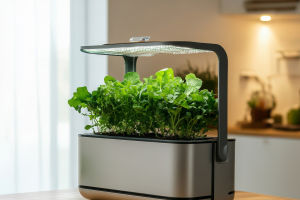We all love the idea of bringing plants into our homes, but for those of us with limited space, it can feel like a challenge. Luckily, there's a creative solution: vertical gardening!
Vertical gardens are a fantastic way to maximize small spaces and bring greenery into our lives without compromising on style or functionality.
Whether you live in a tiny apartment or a small office, vertical gardens allow us to make the most of our limited square footage, transforming blank walls into living works of art.
In this article, we'll explore the concept of vertical gardening, how it works, and some practical tips for setting up your own vertical garden at home.
What Is Vertical Gardening?
Vertical gardening is simply the practice of growing plants in a vertical space—typically on walls, fences, or specially designed structures. This method allows us to cultivate a variety of plants while using minimal horizontal space, making it perfect for apartments, small homes, or areas with limited outdoor space.
In vertical gardens, plants can be grown in containers, wall-mounted planters, or even within the structure of a living wall, which is a large, vertically oriented surface covered with plants. These gardens can range from small-scale setups using a few pots to large, elaborate installations that can cover entire walls with greenery.
Benefits of Vertical Gardens for Small Spaces
One of the main reasons we turn to vertical gardens in small spaces is the ability to maximize available space. Unlike traditional gardens, which require large plots of land or big containers, vertical gardens allow us to grow plants vertically, utilizing unused wall space. This is especially beneficial for apartments or small homes where horizontal space is limited.
Besides saving space, vertical gardens can improve the overall aesthetic of your living area. They act as a striking focal point, adding color, texture, and life to a space that might otherwise feel dull. Whether it's a few plants on a living room wall or a large installation in a hallway, vertical gardens instantly enhance the ambiance of any room.
Additionally, vertical gardens can improve air quality. Plants naturally filter the air by absorbing carbon dioxide and releasing oxygen, helping to purify the air in your home. This is especially valuable in small spaces where air circulation might be less than ideal.
Choosing the Right Plants for Vertical Gardens
When selecting plants for your vertical garden, it's important to consider both the plants' needs and your available space. Some plants thrive in the conditions that vertical gardens offer, while others may not do well in confined vertical spaces.
Low-maintenance plants are often the best choice for beginners. Plants like pothos, snake plants, and succulents are hardy, adaptable, and require minimal care. These plants also work well in vertical planters as they don't need a lot of attention and can grow well in indirect light.
For a more lush, tropical feel, you could opt for plants like ferns, ivy, or peace lilies. These plants thrive in humid conditions and are perfect for creating a verdant, jungle-like atmosphere in your space. They also do well when placed in a vertical setup, as long as they have enough light and proper watering.
If you're looking to grow herbs or edible plants, vertical gardens are ideal. Mint, basil, and thyme can be grown in small wall-mounted planters or vertical hydroponic systems, offering fresh ingredients for your kitchen without taking up counter space.
Setting Up Your Vertical Garden
Now that we know the benefits and plant choices, let's get into the practical side of setting up a vertical garden. There are several methods and materials available, depending on your needs, style, and budget.
1. Wall-Mounted Planters: These are one of the simplest ways to get started with vertical gardening. You can purchase pre-made wall planters that can be attached to any flat surface. These planters can be used for small plants like herbs or decorative flowers.
2. Living Walls: If you're up for a more ambitious project, consider installing a living wall system, which consists of a framework that holds plants in place vertically. These systems often include irrigation features to keep the plants hydrated, making them ideal for larger spaces or more complex plant setups.
3. Trellises or Ladders: For plants that like to climb, such as climbing roses or tomatoes, using a trellis or ladder structure is a great option. These vertical supports allow the plants to grow upwards, saving valuable space while also creating a visually appealing display.
4. Vertical Hydroponics: For the tech-savvy gardener, hydroponic vertical systems allow plants to grow without soil. This system uses water and nutrients to nourish the plants, making it ideal for growing herbs, leafy greens, or even strawberries in a small space.
Maintaining Your Vertical Garden
Maintaining a vertical garden is relatively easy, but it does require some attention. Regular watering is essential, as the plants may dry out faster in vertical systems due to their exposure to air. For wall-mounted planters, make sure the watering system is efficient and that the water doesn't spill or drip onto the walls.
It's also important to ensure that the plants are getting enough sunlight. Depending on the placement of your vertical garden, you may need to rotate your plants to ensure even exposure to light. If your space has limited natural sunlight, you can supplement with grow lights to give your plants the energy they need to thrive.
Conclusion: Your Vertical Garden Awaits!
Vertical gardening is an excellent solution for those of us living in small spaces but still yearning for the beauty and benefits of plants. By using creative techniques like wall-mounted planters, living walls, or hydroponic systems, we can grow a variety of plants while maximizing our limited space.
So, are you ready to start your own vertical garden? Whether you're looking to add a few small plants to your home or create a lush, green wall, vertical gardening can help you make the most of your space. Get creative, and let your green thumb take over!


